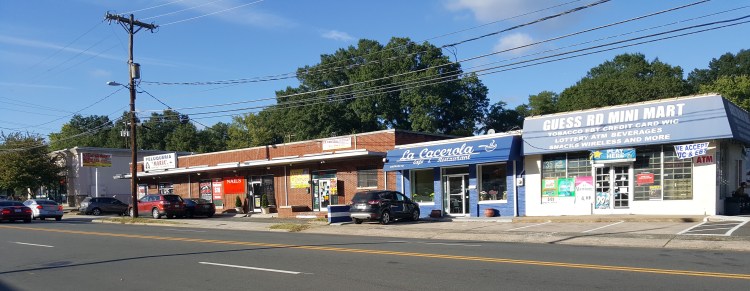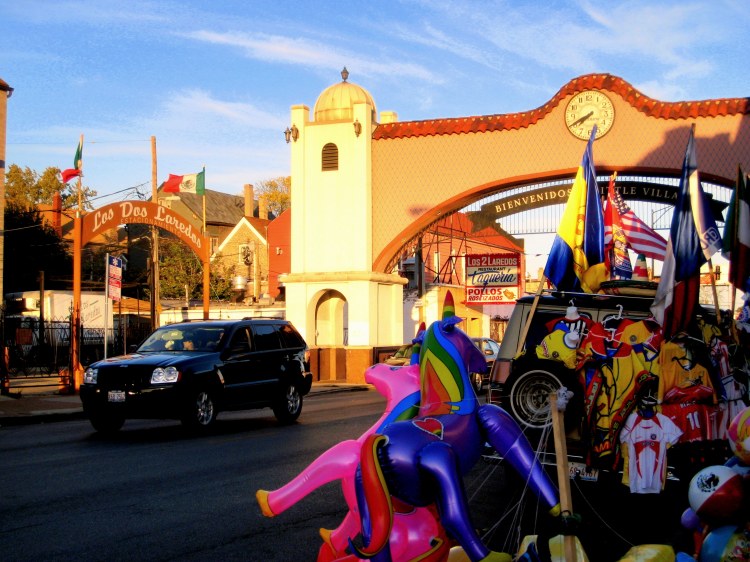Sandoval-Strausz, A.K. Barrio America: How Latino Immigrants Saved the American City. New York: Basic Books, 2019.
Reviewed by Maricio Castro
In August of 2017 I moved to Durham, North Carolina. Because I could not go apartment hunting ahead of time and because I had a very large dog that many landlords would not take, I had taken a unit in a duplex I had found on the internet. Upon arriving I looked at my recently renovated apartment and at the neighborhood surrounding it and came to a realization: I was a gentrifier. My dwelling, at the edge of Walltown, was in what is often euphemistically referred to as a transitional neighborhood. It was an area, I would later learn from neighbors who had lived there for over a decade, that had changed significantly in terms of its economy and safety. Early on, when taking my dog for a walk, I turned onto Guess Road and took a picture of a row of Latino businesses across the street.

I wondered, in the midst of the changes to the neighborhood, how long before these businesses started feeling the pressure of higher rents. Less than two weeks later I took another picture that made a companion piece to the first: on the next block, a newly renovated apartment building advertised the availability of “Brand New Luxury Apartments.”

I took these photographs because they resonated with the courses that I would be teaching that year and because they reminded me of the work of A.K. Sandoval-Strausz, now best exemplified by his book Barrio America: How Latino Immigrants Saved the American City. In this important monograph, Sandoval-Strausz challenges the common knowledge that credits the comeback of American cities from disinvestment and “white flight” to the broad category of white-collar professionals, intellectuals, and artists labelled the “creative class.” Rather, the author goes to great lengths to show and explain the contributions of Latino Immigrants to the cities they made their home and how they helped bring them back from the brink. In doing so, Sandoval-Strausz helps readers understand recent shifts in the American urban landscape cannot be attributed the actions of moneyed classes, but can only be clearly understood by explaining how “a group of people who earned modest incomes and were socially marginalized, politically demonized, and sometimes undocumented managed to redeem so much of metropolitan America.”
 While Barrio America is centered on two neighborhoods, Chicago’s Little Village and Dallas’s Oak Cliff, Sandoval-Strausz’s approach to the shifting nature of North American cities is decidedly transnational. He sets the decline and anti-urbanism of the mid-twentieth-century United States in a global context and explains how the immigrants who settled in these areas imported key elements of Hispanic-Indigenous spatial culture to create “a new model of city life that combined key features from across the hemisphere.” This Latino urbanism is central to the contributions of Latino immigrants to places like Little Village and Oak Cliff, where they established a form of urbanism that deemphasized the use of cars, increased foot traffic to local businesses, and made common use of public space. This infusion of new residents and their contributions mitigated the depopulation of these areas, helped local businesses survive through increased foot traffic, and brought down crime rates through persistent public presence.
While Barrio America is centered on two neighborhoods, Chicago’s Little Village and Dallas’s Oak Cliff, Sandoval-Strausz’s approach to the shifting nature of North American cities is decidedly transnational. He sets the decline and anti-urbanism of the mid-twentieth-century United States in a global context and explains how the immigrants who settled in these areas imported key elements of Hispanic-Indigenous spatial culture to create “a new model of city life that combined key features from across the hemisphere.” This Latino urbanism is central to the contributions of Latino immigrants to places like Little Village and Oak Cliff, where they established a form of urbanism that deemphasized the use of cars, increased foot traffic to local businesses, and made common use of public space. This infusion of new residents and their contributions mitigated the depopulation of these areas, helped local businesses survive through increased foot traffic, and brought down crime rates through persistent public presence.
What is most remarkable about this narrative is that, as Sandoval-Strausz points out, “Latino community achievements are what they are despite the ongoing neglect of neighborhoods like these—the underinvestment, especially in education, and the low wages, persistent overwork, and resultant levels of poverty.” In fact, these communities were often seen by older residents of these neighborhoods not as a positive force, but rather as a growing problem. This, combined with the adoption of new laws that criminalized non-violent offenses for both documented and undocumented residents, allowed for these communities to be portrayed as criminal despite their contributions.
Sandoval-Strausz is careful to avoid the sorts of essentialist arguments about race and cultural traits that could be a pitfall to this sort of study. He points out that the urban crisis is often mistakenly attributed to the shortcomings of African Americans while Latinos are assigned attributes that are more positive but no less stereotypical. He stresses that his book is not about racial difference and that it focuses more on structural forces rather than cultural ones. In fact, some of the most memorable material in the book illustrates individuals and trends that specifically made allowances for Latino immigrants to inhabit spaces from which African Americans were barred. Sandoval-Strausz writes that Latinos were “racially undefined” and this allowed figures like real estate agent Richard A. Dolejs to accept them in their neighborhoods or even consider them a bulwark against the entry of African Americans into those same areas. The author goes even further in complicating the stories of this complex racial landscape by documenting the embrace of whiteness of Latinos and the adoption of racist rhetoric against African Americans by different groups and individuals.
Barrio America’s structure, divided into three parts that cover this history from 1950 to the mid-2010s, serves readers quite well. I recently taught the book to a class of undergraduates and was very pleased with how Sandoval-Strausz is able to combine a history of the urban crisis with a clear delineation of the trends in American immigration policy of the past seven decades. The result is a monograph that is thoroughly accessible to general audiences, but which provides specialists with exciting new material and which engages the work of the author’s contemporaries in the field.
There are places where the reader might be left wanting more. My students, for example, wanted to see how elastic Sandoval-Strausz’s model was when applied to other urban spaces and to see greater attention paid to the complexities of racial conceptions within Latino communities. These, however, feel like new avenues of research for other scholars to explore, building on this work.
Sandoval-Strausz once called for a study of the “next urban history: one that analyzes U.S. cities in their transnational contexts, particularly as they relate to the Americas.”[1] Barrio America is not the final word on Latino urban history. This is a growing field already rich with the work of talented scholars. The book is, however, already helping bring this field’s contributions to a wider audience in need of deeply researched works that cut through decades of prejudice, misconceptions, and bad faith arguments and illuminate the contributions of Latinos to America’s cities. Sandoval-Strausz has written a book that scholars will be in conversation with for a long time to come and which has the potential to help shape some of the conversations at the forefront of American political and social discourse.
 Mauricio Castro is Assistant Professor of History at Centre College. He holds PhD and Masters degrees in American history from Purdue University and a BA in history from Vassar College. His research focuses on the development of post-1959 Miami as a function of both federal Cuban refugee policy and the Cuban diaspora.
Mauricio Castro is Assistant Professor of History at Centre College. He holds PhD and Masters degrees in American history from Purdue University and a BA in history from Vassar College. His research focuses on the development of post-1959 Miami as a function of both federal Cuban refugee policy and the Cuban diaspora.
Featured image (at top): Street view of Latino businesses in Chicago’s Little Village neighborhood. [Peter Fitzgerald, “Little Village (La Villita) Downtown Strip, Chicago” (2007), Wikimedia Commons]
[1] A.K. Sandoval-Strausz, “Latino Landscapes: Postwar Cities and the Transnational Origins of a New Urban America,” The Journal of American History 101, no. 3 (2014), 805.



This otherwise excellent review and perhaps the book itself use the term Latino as a catchall without attempting to make any distinction between the range of nationalities and cultures within the broad category. eg. Mexicans, Puerto Ricans, Cubans, Colombians, Argentines, Chileans and Brazilians.
As we can without apology make distinctions as to the culture and outlook of say, Sicilians and Swedes, why not extend the same courtesy and useful analysis to Hispanics?
Regards, Jim Wunsch
LikeLike